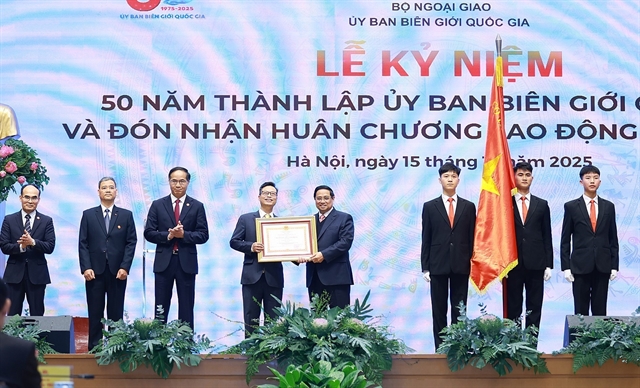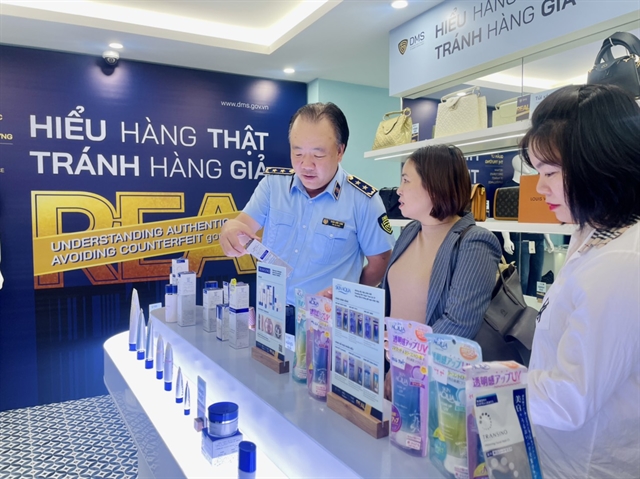 Society
Society

The application of digital technology into the process of buying and selling goods is believed to become a "lifesaver" for Vietnamese businesses in the fight against smuggling, trade fraud, production and trading of counterfeit and substandard goods.

|
| Việt Nam Directorate of Market Surveillance runs a showroom theme “Understanding authentic goods - Avoiding counterfeit goods” on November 24 to respond to Vietnamese Anti-Counterfeiting Day (November 29) in Hà Nội.— Photo baotintuc.vn |
HÀ NỘI — Both the Government and Prime Minister have issued many mechanisms, policies and solutions to fight against smuggling, trade fraud, production and trading of counterfeit and substandard goods, including digital technology solutions.
The project on anti-counterfeiting and consumer protection in e-commerce until 2025 was approved by the Prime Minister in Decision No. 319/QĐ-TTg on March 29, 2023.
It aims to perfect the system of policies and laws on inspection and handling of administrative violations on standards, measurement, quality of products goods, and labels in e-commerce activities; complete the system of national standards and national technical regulations on product and goods quality; promote activities to apply codes, barcodes and trace the origin of products and goods.
In addition to sanctions in legal documents related to anti-counterfeit and counterfeit goods, the application of digital technology into the process of buying and selling goods is believed to become a "lifesaver" for Vietnamese businesses.
Nguyễn Đức Lê, deputy director of the Professional Skill Division, under the Việt Nam Directorate of Market Surveillance, said many suspects were found to take advantage of loopholes in the internet to trade counterfeit, banned and smuggled goods, affecting the business environment of enterprises, causing loss of revenue for the tax sector as well as loss of consumer confidence.
He said that making anti-counterfeit stamps one of the anti-counterfeit technology solutions was an effective solution so far.
Currently, many new modern technologies have been applied by businesses and authorities in order to actively fight against counterfeit goods.
Bùi Minh Cường, director of the Science and Technics Publishing House under the Ministry of Science and Technology, said the publishing house had coordinated with many companies to produce anti-counterfeit smart stamps, certified by the Ministry of Public Security and the Ministry of Science and Technology.
The publishing house was also working with agencies to produce anti-counterfeit stamps in cyberspace, which was expected to be deployed from the beginning of 2025. All e-publications of the publisher would be able to combat pirated and fake books in cyberspace in the near future, he said.
At the National Numbering and Barcodes Centre under the science and technology ministry, the National Product Traceability Information Portal has been operated.
It is considered an important solution that contributes to ensuring the safety and quality of products, thus enhancing the competitiveness of businesses, protecting the rights of consumers and helping to build a transparent and sustainable economy in terms of traceability of goods origin.
Trần Văn Việt, head of the centre’s International Cooperation Office said that the portal played the role of connecting independent traceability systems.
When consumers scanned, the portal would link traceability data together to provide consumers with a preliminary picture of the product through steps such as production stage and transportation to the customers, he said.
Bùi Bá Chính, deputy director of the centre, said the centre was assigned as the focal unit to implement Decision No. 100/QĐ-TTg of the Prime Minister on deploying, applying and managing the origin traceability system.
It worked with solution providers to establish the portal. The portal, which connected State management systems of ministries, sectors and localities nationwide, was scheduled to link with origin traceability systems around the world in the coming time so that domestic and imported goods can have the most transparent information of origin, he said.
Chính also added that the portal had gained acceptance from authorised agencies since November 2022. It already connected with two localities of Yên Bái and Sóc Trăng. It was set to connect with an additional of six provinces and cities across the country soon.
Currently, the portal has database of more than 4,000 products, mostly foods and functional foods. People can scan the code on the portal to get product information. The centre has issued 70,000 business codes.
After being granted the codes, the businesses proactively generated trade codes for their products.
If we applied the tools of codes, barcodes and other similar identification tools during the product creation process, the digitalisation process of the entire product chain would be fully and more easily implemented, he said.
According to Chính, after digitised product information was posted to the portal, systems of ministries, sectors, localities and other e-commerce sites, the product information would be easily accessible by authorities as well as people.
Therefore, digitisation and information transparency were truly an effective tool to fight against fake, counterfeit, and substandard goods.
If the process of digitisation and information transparency was carried out actively, it would be one of the most fundamental, long-term and sustainable solutions for businesses to fight against counterfeit, fake and substandard goods.
Besides, consumers need to be equipped with more knowledge to choose products with clear origins.
“The easier, more transparent and verifiable the information is to access, the lower the probability of damage from fake, counterfeit or poor quality goods,” he said.
Businesses should be more aware of digitalisation to protect their own brands and coordinate with other authorities and the consumer community to join hands in the fight against counterfeit goods, according to the official. — VNS




